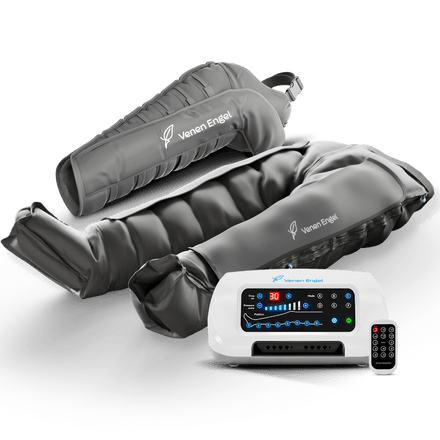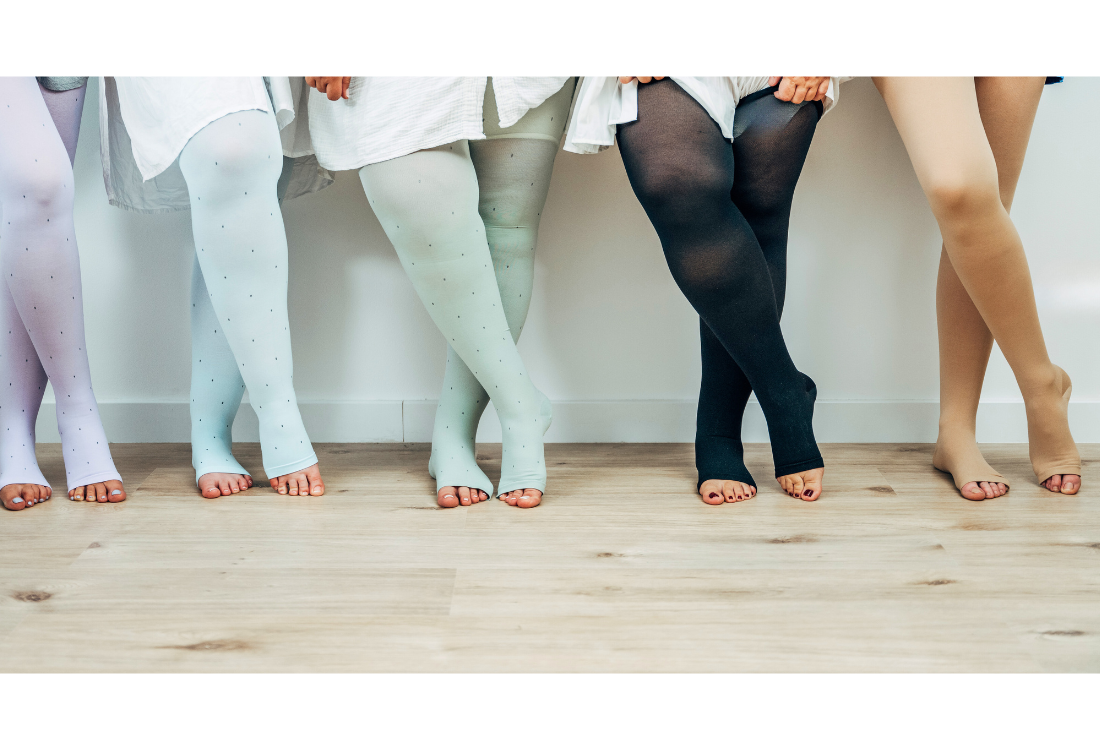
Every leg is different
Finding the right compression stockings can be crucial for your daily well-being. Let's discover together how to find the perfect stockings, whether for work, sport or leisure.

Select compression stockings
Understanding certification
Medically certified compression stockings are manufactured according to strict medical standards and are provided with precise pressure values that enable targeted treatment of venous disorders such as varicose veins or lymphoedema. They can also be prescribed by a doctor and are available in various compression classes.
Non-certified compression stockings usually provide general compression without specific medical certification or standards. These stockings may provide some compression without being therapeutically effective.
Sophie, 28, teacher: Sophie works as a primary school teacher and spends most of her day standing or walking. Due to a family predisposition, she has an increased risk of varicose veins. Her doctor recommends medical compression stockings to improve blood circulation and prevent swelling. Sophie opts for colourful compression stockings in various colours such as blue and lavender. These stockings help her health and she has already been approached by her class about the great colours.
Select compression stockings
Understanding compression classes
Compression class I (light compression, approx. 18-21 mmHg): This class offers light pressure and is ideal for mild complaints such as tired or swollen legs after long periods of sitting or standing. It is often used as a preventative measure to prevent varicose veins.
Compression class II (medium compression, approx. 23-32 mmHg): This class is recommended for more pronounced symptoms, such as varicose veins, minor venous disorders or after certain operations. It provides stronger pressure and supports blood circulation more effectively.
Compression class III (strong compression, approx. 34-46 mmHg): This class is suitable for more severe venous disorders, chronic venous insufficiency or after thrombosis. It offers even stronger support and is often only available on medical prescription.

- Sandra, 25, office worker: Sandra sits in the office all day and often has swollen legs in the evening. So Sandra opts for compression class I to prevent swelling and support blood circulation.
- Marie, 28, nurse: Marie is on her feet all day and often notices that her legs are swollen and tired in the evening. She also chooses compression class I to alleviate her discomfort.
- Sophie, 45, teacher: Sophie has a family history of varicose veins and is experiencing increasing discomfort. She also chooses compression class II to manage her symptoms and support vein function.
- Claudia, 40, sales assistant: Claudia stands a lot in her job and is already showing the first signs of varicose veins. So Claudia opts for compression class II to alleviate her symptoms and prevent the formation of further varicose veins.
- Eva, 55, nurse: Eva suffers from chronic venous insufficiency and already has severe symptoms. She opts for compression class III to support her vein function and alleviate her symptoms.
- Ursula, 60, pensioner: Ursula often has pain and swelling in her legs after a thrombosis. She chooses compression class III to alleviate the symptoms and improve her quality of life.
Select compression stockings
The right fit
To find the right size, it is important to measure your legs correctly. This is best done in the morning when your legs are not yet swollen. Measure the circumference in the following places:
- Ankle (narrowest point)
- Calf (widest point)
- Thigh (widest point)
Make a note of the measurements and compare them with the manufacturer's size charts.

- Anna, 35, project manager: Anna has a petite figure and needs to make sure that her compression stockings fit well. She uses the manufacturer's size chart carefully and checks that her measurements are within the specified ranges.
- Michaela, 37, bank employee: Michaela has slightly stronger calves and often has difficulty finding stockings that fit. She carefully compares her measurements with the size charts and tries out different models to find the best fit.
Select compression stockings
The right material
Compression stockings are available in different materials, which offer different advantages and disadvantages:
- Cotton: Breathable and skin-friendly, but less elastic.
- Nylon: Very elastic and durable, but can be less breathable.
- Microfibre: Soft and comfortable, with good breathability and moisture regulation.

Lisa, 45, teacher: Lisa has sensitive skin and sweats easily. She prefers microfibre compression stockings as they are soft, comfortable and breathable, which makes them more comfortable to wear.
Select compression stockings
The right look
Medical compression stockings in great colours are also popular at the moment! You can choose between different patterns, colours and lengths to match your stockings perfectly to your style. Your Venen Engel compression stockings also come in classic black and nude as well as trendy shades of blue, purple and green. You can also decide whether you fancy a cute polka dot design, as your compression stockings from Venen Engel also offer this on request.

- Julia, 30, marketing specialist: Julia attaches great importance to her appearance and wants her compression stockings to look stylish. She chooses neutral colours such as black and nude for a formal office look or more vibrant colours and patterns for a fashionable accent.
- Nina, 33, fashion blogger: Nina wants to integrate her compression stockings into her outfits and therefore looks for fashionable and eye-catching designs. She opts for bright patterns and bold colours to use her stockings as a fashion accessory.
Select compression stockings
Every leg is different
Choosing the right compression socks depends on several factors, including compression class, fit, material and design.
- Medical certification: A good choice if you need targeted support for venous disorders.
- Compression class: Choose the class according to your symptoms.
- Fit: Measure your legs carefully and check the manufacturer's size charts.
- Material: Look for materials that meet your requirements.
- Design: Choose designs and colours that suit your style and make you feel comfortable.














